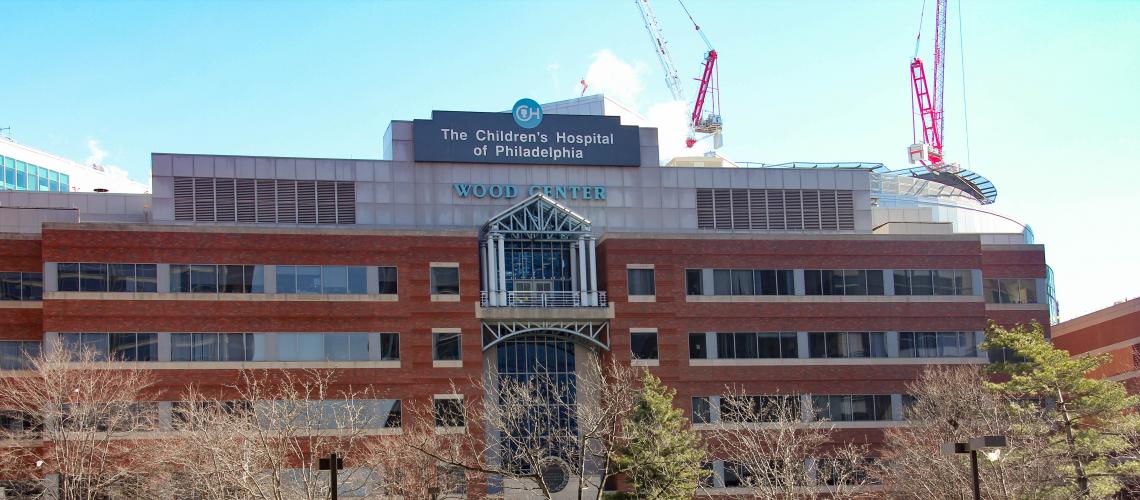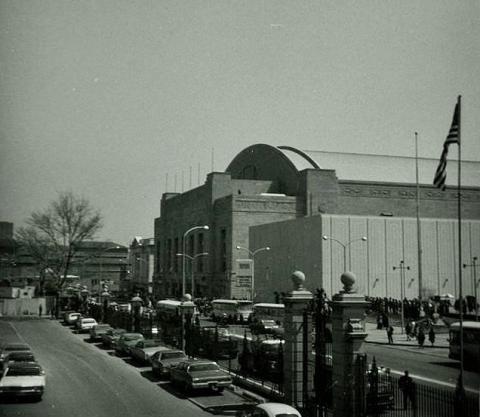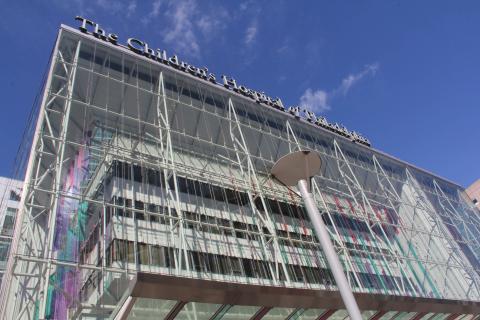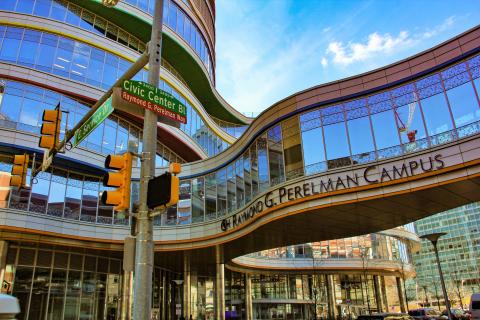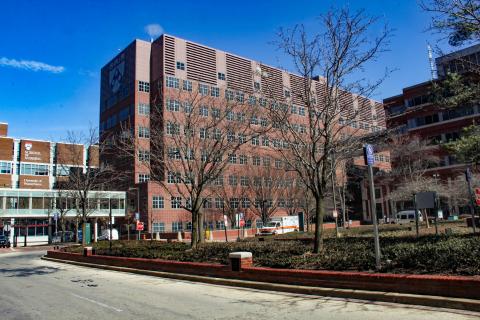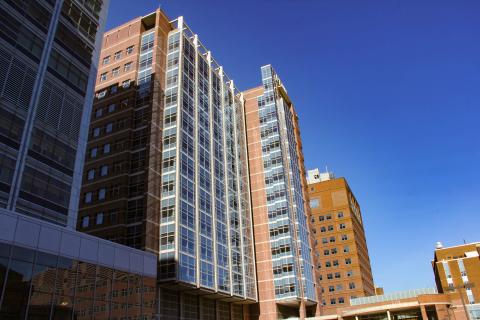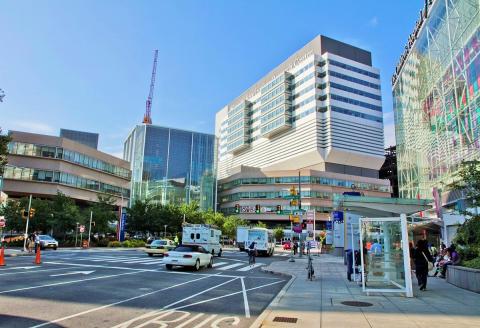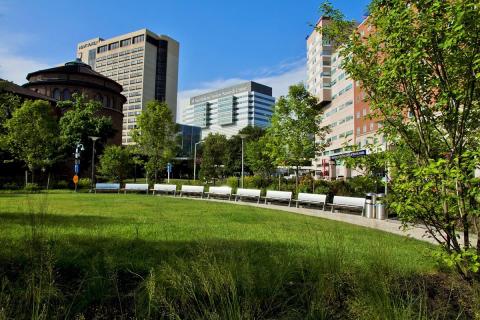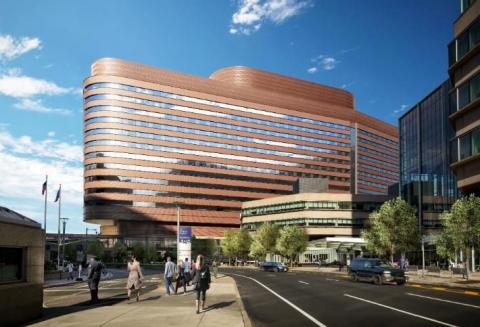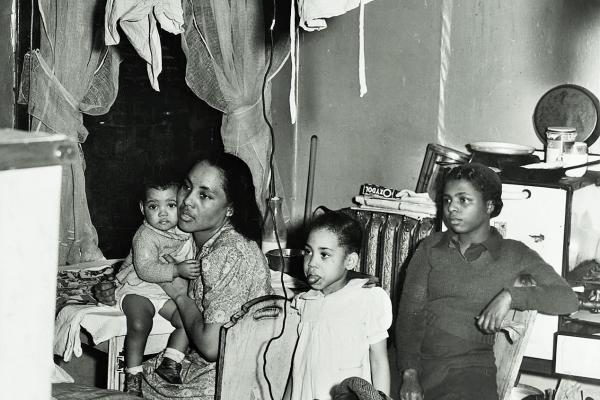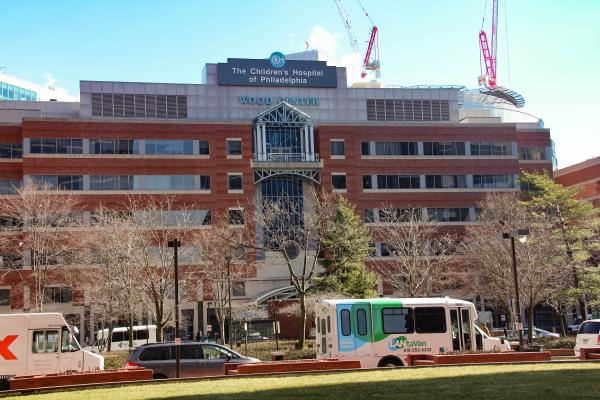After PGH: A City of Healthcare Sciences in West Philadelphia
PGH’s closing in 1977 unleashed a bidding war for the leveled site that was eventually won by a consortium that included Penn, Children’s Hospital of Philadelphia (CHOP), Children’s Seashore House, and the Veteran’s Administration. The consortium, called the PGH Development Corporation, built the Philadelphia Center for Healthcare Sciences, a complex of seven new buildings on the former PGH property.
In 1977, the City, under Mayor Frank Rizzo, closed PGH, claiming it was no longer affordable. A consortium called the PGH Development Corporation, which included Penn, Children’s Hospital of Philadelphia (CHOP), Seashore House, and the Veteran’s Hospital eventually gained control of the site, named it the Philadelphia Center for Healthcare Sciences, and put up seven medical research and treatment buildings between 1988 and the Millennium. In a parallel development, Penn and CHOP acquired the City’s Civic Center properties on Civic Center Boulevard opposite the former PGH site and put up avant-garde clinical and medical research facilities, and a parking garage. In combination, the Philadelphia Center for Healthcare Sciences and the Penn/CHOP expansions have created a veritable City of healthcare sciences in West Philadelphia.
PGH’s postwar improvements and contributions were relatively short-lived. Lisa Levenstein neatly sketches federal developments in healthcare funding that impacted negatively on the public hospital and made its services no longer affordable by the City. “Of all the public institutions from which working-class black women sought essential services, PGH proved the most vulnerable to budgetary pressures,” Levenstein writes. “In the late 1960s and 1970s, the hospital faced a serious financial crisis as an unintended result of major shifts in public policy. The establishment of Medicare and Medicaid changed the system of healthcare funding by subsidizing services for the elderly and medically indigent at private hospitals and clinics. With rising standards of care requiring substantial capital expenditures, the City fought with the medical schools in Philadelphia over rates of compensation for physicians and services. The hospital became increasingly expensive to operate and its facilities deteriorated. In 1976, the Democratic mayor, Frank Rizzo, announced plans to close PHG, inspiring a groundswell of community opposition. Labor unions, doctors, nurses, welfare rights activists, healthcare advocates, black churches, and patients all joined forces to keep PGH open, organizing marches, public demonstrations, and work stoppages. Yet PGH was closed in 1977, and Philadelphia lost an institution that had been the bedrock of the black community and a touchstone for the entire City.”[1]
In November 1978, Mayor Rizzo announced that the City was “offering 19 acres of cleared land for private development.” Given the proximity of the old PGH site to the Hospital of the University of Pennsylvania (HUP) and that hospital’s parking needs, Penn had a vested interest in the site’s future, calling for expansion of the Children’s Hospital of Philadelphia (CHOP), next door to HUP; parking facilities for CHOP, HUP, and the Convention Center; and “comprehensive planning” for a “mix of uses,” such as “residential apartments, retail commercial space, and a tax-ratable office building.”[2] Yet a year later, University planners learned to their dismay that the City was under pressure from the U.S. Department of Housing and Urban Development to designate 20 percent of the housing built on the site as Section 8 housing (privately owned, subsidized rental housing for low- and moderate-income families). By this point Penn’s aim was to be the City’s sole designated redeveloper with a writ to transform the entire nineteen-acre site as a hub of medical research facilities. The first developer to enter a bid for the entire site was Barness Organization of Warminster in the late fall of 1979, whose president, Herbert Barness, was reportedly a suburban house builder and race-track investor.[3] As matters stood, Barness was legally obligated to include Section 8 housing in his plan. Penn planners, who saw that the University’s institutional self-interest in HUP and CHOP depended on securing the site for medical research and healthcare facilities, opposed Section 8 housing because it would jeopardize that goal. With the 27th Ward leader, they argued reasonably that the PGH site was too remote from schools and “too isolated . . . to be practical for families with children.” (The site’s enveloping institutional neighbors, in addition to the two hospitals, were the City morgue and the Veteran’s Hospital.) The University’s opposition, however, left it vulnerable to a charge of racism by African American community leaders mindful of Penn’s role in urban renewal in the 1960s.[4]
Two years later HUD and the City were looking for other sites for Section 8 housing. In the end, HUD and the City agreed to another private developer’s plan to build Section 8 housing on property formerly owned by the University City Science Center at 39th and Market streets, a design that came to fruition in 1984.[5] Barness would fail to build any apartments on the site, even after tailoring his plan to align with the dramatic events that began to unfold in 1983.
As reported in April 1983, the City, Penn, CHOP, the Children’s Seashore House, and the Veteran’s Administration agreed that the closed PGH site should be used for purposes related to health care. Six months later, a consortium formed by these organizations began work on a proposal for a $250 million healthcare complex, which would include three new medical-related University buildings, a CHOP facility for ambulatory care, a facility for Seashore House (a rehabilitation hospital for acutely ill and several disabled children), and a cancer-research center to be built by Noguchi Institute of Japan—a total of seven new buildings for the site.[6] Calling themselves the Health Center Group (later the PGH Development Corporation), the consortium submitted its proposal for the seven-facility complex to the Philadelphia Industrial Development Corporation (PIDC), the City agency responsible for the site’s development, in November 1985. The Health Center Group’s executive director was quoted as saying, “We’re one step closer to bringing health care back to the former PGH site. And that means we’re one step closer to catapulting Philadelphia to the forefront of the nation’s healthcare industry.” The PIDC was equally enthusiastic.[7]
Buildings were rising in 1988 in the Philadelphia Center for Health Care Sciences, PGH’s former site, with costs now projected at $457 million ($975 million in 2018 dollars). The Center’s executive director predicted the creation of 2,500 new jobs for the City. A federal Urban Development Action Grant funded site improvements such as roadway development and landscaping in the Center. The VA Medical Center, across University Avenue from the new center, was conducting its own $102 million expansion.[8]
Penn’s first building in the complex was the eight-story Clinical Research Building, designed by the firm Venturi, Scott Brown & Associates and completed in 1989 under President Sheldon Hackney— described by the Inquirer as “the most striking building on the site. . . [Its] taut skin is formed by richly hued bricks capped with light purple proclaim-enameled steel panels. A giant 25-foot Penn insignia . . . floats at the top of the building.”[9] In 1999, Penn, under President Judith Rodin, completed the 14-story Biomedical Research Building II/III (or BRB II/III), which today houses Raymond G. Perelman Medical School departments and centers for biological research. BRB II/III is connected to the Medical School’s Stellar-Chance Laboratories by a bridge over Curie Avenue.[10]
Under Rodin, Penn embarked on a major expansion of its healthcare system, then called the Penn Health System, now called Penn Medicine. With the City’s blessing, Penn was able to purchase a large swath of the public property on which the Civic Center—Convention Hall and the Civic Center’s Grand Exhibition Hall—stood. That complex looked across Civic Center Boulevard to the Philadelphia Center for Health Care Sciences. The aim of this acquisition was twofold: “first to build a single comprehensive facility for all out-patient treatment, next to build a research facility.” CHOP received a slice of the Civic Center site on which to build a pediatric research and treatment complex. CHOP and HUP jointly acquired a parcel a the south end of the site on which to build a parking garage. Demolition of the Civic Center was under way in 2004.[11]
Spectacular developments marked the completion of one of the world’s finest heath care and medical research complexes—a veritable City of healthcare sciences in West Philadelphia. Under Amy Gutmann, Penn’s president since 2004, the University financed and built the $305 million Perelman Center for Advanced Medicine, which today houses avant-garde facilities for HUP’s clinical specialties, including, among other services, pioneering cancer treatment, cardiovascular medicine, and outpatient surgery. Connected to the Perelman Center is the Gutmann-era, $140 million Roberts Proton Therapy Center, which provides advanced radiation therapies. Open in 2011, the Smilow Center for Translational Research, “a medical research town with eight ‘football-field-size’ floors of research space,” rises above the Perelman Center.[12]
In the 1990s and early 2000s, when media outlets celebrated the building of a city of healthcare sciences, HUP (among other Philadelphia hospitals) found itself in the morally correct but financially unsustainable position of providing unreimbursed health care to low-income residents who were ineligible for Medicaid or Medicare—operating in these cases as a de facto public hospital. One astute commentator noted, “What makes matters worse is that the fattest city in America is also the largest without a public hospital system, and the state government does next to nothing to compensate the private hospitals that must bear the cost instead.”[13]
[1] Lisa Levenstein, A Movement without Marches: African American Women and the Politics of Poverty in Postwar Philadelphia (Chapel Hill: University of North Carolina Press, 2009), 186–87. Penn’s student newspaper, The Daily Pennsylvanian, closely followed the closing of PGH with such articles as “City Will Close PGH; Hospital Administration Surprised by Decision,” 16 February 1976; and “Court Rebuffs Attempt to Avert PGH Shutdown,” 16 March 1976.
[2] “PGH Tract to Be Razed,” Daily Pennsylvanian, 28 November 1978.
[3] “In Phila., a Battle Over Site,” Philadelphia Inquirer, 9 December 1979.
[4] “But Not in Our Neighborhood,” Daily Pennsylvanian, 6 April 1979.
[5] “City Seeks New Sites for Section 8 Housing,” Daily Pennsylvanian, 24 September 1981.
[6] “250 Million Health-Care Complex Set for PGH Site,” Daily Pennsylvanian, 7 September 1984.
[7] “At PGH Site, Health Center is Planned,” Philadelphia Inquirer, 10 November 1985.
[8] “City to Benefit from Construction of a Major Center—for Health Care,” Philadelphia Inquirer, 6 November 1988.
[9] “A Healthy Balance of Buildings?” Philadelphia Inquirer, 24 September 1989.
[10] John L. Puckett and Mark Frazier Lloyd, Becoming Penn: The Pragmatic American University, 1950–2000 (Philadelphia: University of Pennsylvania Press), 309.
[13] John Kastor, Governance of Teaching Hospitals: Turmoil at Penn and Hopkins (Baltimore: Johns Hopkins University Press, 2004), 30–31; “Study Finds HUP Largest Loser in Area,” Daily Pennsylvanian, 21 June 1990; quote from Binyamin Appelbaum, “It Ain’t Easy Being UPHS,” opinion, Daily Pennsylvanian, 2 March 2000.
